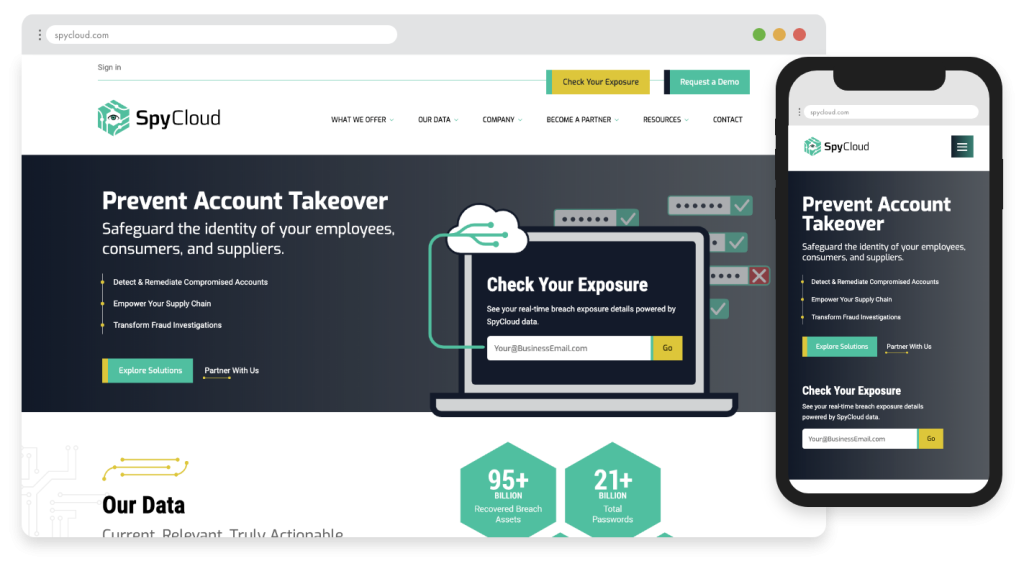Main Menu

SpyCloud offers powerful, easy-to-use solutions to prevent online fraud by stopping account takeover (ATO) attacks.
SpyCloud quickly recovers the most current breached data directly from the criminal underground and makes that data truly actionable. As the trusted ATO prevention partner for B2B organizations and consumer brands, SpyCloud’s solutions ultimately make the internet a safer place to do business.

As a well-respected Austin startup in the cybersecurity industry, SpyCloud came to us ready for a digital presence that could support the rapid growth the company was experiencing. With a premier solution to thwart online fraud, SpyCloud’s existing site offered a modern aesthetic but was lacking critical components for success: intuitive navigation, effective user engagement, and high-quality lead generation. Additionally, the site provided a confusing administrative experience, making it challenging for nontechnical staff members to make any updates.
As SpyCloud grew, so did the need to better inform and educate potential customers about its powerful ATO solutions. SpyCloud approached HMG looking for an agency partner that could help the brand better define its direction and purpose and equip it with a scalable digital solution that better engaged target audiences.

Brand Strategy
One of SpyCloud’s greatest obstacles was ineffective messaging surrounding the company’s services and purpose, so we took things back to square one and redefined the brand through a comprehensive brand strategy.
Our team interviewed current and potential clients of SpyCloud, as well as employees and stakeholders. We brought the results and our research to an interactive Discovery Workshop with the team where we worked through exercises to uncover what it is that makes SpyCloud so awesome.
We helped SpyCloud craft a compelling vision and mission statement that not only communicates the company’s current focus but also takes into account its role in the future of cybersecurity.
Web Design
Once it was time to start on the web phase of the project, our team already had a thorough understanding of SpyCloud’s overall business objectives, brand story, website goals, and audiences. Before we started on visual design, we dove into establishing an intuitive sitemap and content hierarchy that better communicated SpyCloud’s value to the specific users visiting the site.
With the challenge of needing to create a site that equally engages different audiences with varying objectives, our design team used the personas defined in brand strategy to create user journey maps, illustrating the different journeys possible for users on the site.
Our goal with the visual design of the website was to leverage the brand equity SpyCloud had already established with its modern brand aesthetic. Starting with SpyCloud’s powerful hexagonal logo, we capitalized on the unique shape as a core design element throughout the site.
We also leveraged the circuitry imagery found in the logo as a secondary design element. Adding to the rich iconography and illustrations SpyCloud already had, we further equipped the brand with a set of custom-designed icons and graphics that were put to use throughout the site.
Web Development
When it came to the development of the site, we knew developing a custom-theme on the WordPress framework would provide the best administrative solution for the SpyCloud team. We then incorporated the Elementor Page Builder as a user-friendly tool that would equip staff members to own the administration of the site.
We also custom developed the WordPress instance to be compatible with the migration to a static environment.

When SpyCloud came to us, its current website was lacking calls-to-action that kept users engaged on the site. Additionally, the site’s primary call-to-action wasn’t generating the quality leads SpyCloud was looking for.
By restructuring the site to better represent the company’s offerings and to more strategically connect with clearly defined target audiences, SpyCloud saw the time on site increase significantly for both organic search and direct visitors.
SpyCloud’s team received detailed training on how to use the Elementor Page Builder to make site updates, leaving the team much less frustrated with administrative responsibilities.
Upon launch, SpyCloud received lots of positive feedback on the overall aesthetics and improved user experience on the new site.